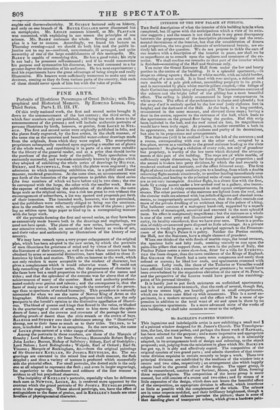INTERIOR OF THE NEW PALACE AT PIMLICO,
THE florid descriptions of what the interior of this building iatolie when completed, but ill agree with the anticipations which a view of its exterior suggests ; and the reason is not that there is any great discrepancy between the gorgeousness of the descriptive phraseology and the orna. mental decorations of. the interior, but that the consideration of fitness and proportion the two grand elements of architectural beauty, are entirely left out of the question. We do not propose to tickle the ears of our readers with a description of the interior in posse, nor shall we be so superfluous as to remark upon the ugliness and meanness of the exterior. We shall confine our remarks to that part of the interior which is finished—consisting of the Hall and Staircase only.
You enter the Grand Entrance Hall from under the low and heavy portico in the centre of the building. It is a splendid apartment,—in
shape an oblong square • the floor of white marble, with an inlaid border, consisting of a neat scroll. It is lined with rose antique, a delicate and rare marble of a pale pink colour, resembling porphyry in its grain ; and is surrounded by plain white marble pillars coupled,—the foliage of their Corinthian capitals being of mosaic gold. The harmonious contrast of the colours and the bright relief of the gilding has a most beautiful effect. The ceiling is plainly ornamented in large compartments in white stucco. The effect of the architecture is chaste and splendid ; but the coup d'ceil is entirely spoiled by the low roof (only eighteen feet in
height) and the darkness of the Hall. At the back, is a long corridor,
ornamented in the same manner, and elevated three steps ; having a door in the centre, opposite to the entrance of the hall, which leads to the apartments on the ground floor facing the garden. Had this strip been included in the hall, and the roof raised six feet, its magnificence would have been truly regal. At present, it rather resembles a bath in its appearance, not alone in the coolness and purity of its decorations, but also in its proportions and arrangements.
The Staircase (will it be credited ?) is on the left of the entrance ; and a recess, corresponding with one at the other end, occupied by a fire.place, serves as a vestibule to the grand staircase leading to the state
apartments ! So glaring a violation of every rule, not only of grandeur but propriety, is worthy of the low taste which dictated the arrange
ments of this part of the building. The steps are tot* white marble, of sufficiently ample dimensions, but far from grandeur of proportion ; and the ascent is broken into petty divisions, by which the tout ensemble is rendered confined and intricate, and the effect frittered away. The first
flight of about twelve steps conducts you to a landing, from which a double returning flight ascends circuitously, to another landing immediately over
the vestibule, and leading to the principal suite of state apartments, which are as yet very incomplete. Another flight, in a direct line with the first, leads by a steep ascent under a low-arched roof to a gallery, also incomplete. This roof is richly ornamented in small square compartments, in stucco. The other portions of the staircase are lighted from the roof, and
the circular walls are adorned with.bas reliefs of figures and classical ornaments, so inappropriately arranged, however, that the effect reminds one more of the private dwelling of an architect than of the palace of eking.
The balluster consists of a mahogany hand-rail, supported by a superb scroll-work of mosaic-gold, conceived and executed in the most splendid taste. Its effect is sumptuously magnificent : but the staircase as a whole
is one of the most petty and ill-contrived pieces of architectural ingenuity, its locality considered,lhat we have ever seen. There is a profu. sion of richly-ornamented parts disposed to little advantage. As a private staircase it would be gorgeous ; as a principal approach to the Presenceroom of the King's Palace it is paltry. Neither the Portico outside, the Hall, nor the Staircase, have a single element of grandeur. When one thinks of the wide floods of marble steps, the broad terraces, the spacious halls and lofty roofs, seeming scarcely to rest upon the palm-like pillars that support them, as seen in the palaces of Italy, the Pindic,o Palace seems a mere show-box, fitter for a villa for EVERING.
TON the linen-draper, thaa the town residence of the Kings of England. But GEORGE the Fourth had a taste more sumptuous and costly than
refined or correct; he liked low roofs, and apartments crammed with.
ornament. Lofty roofs, like those of the Tuileries or Versailles would have afflicted him with a sensation of superior greatness; he would have been overwhelmed by the stupendous elevation of the nave of .St. Peter's, and the perspective of the Louvre would have proved the vanishingpoint of his personal identity.
It is hardly just to put forth strictures on unfinished apartments; but it is not premature to remark, that the roofs of several, though flat, and by no means high, are heavily groined in small compartments, which are in some cases filled up with ornaments. This is a novel experiment, in a modern structure ; and the effect will be a sense of op. pression in addition to the total want of air and space in these by no means spacious apartments. In a more advanced state of the works of this building, we shall take occasion to recur to the subject.


























 Previous page
Previous page